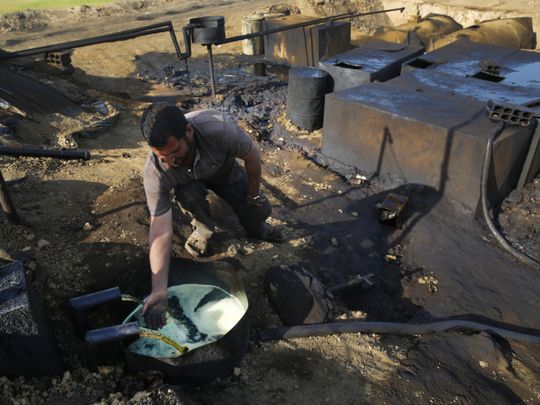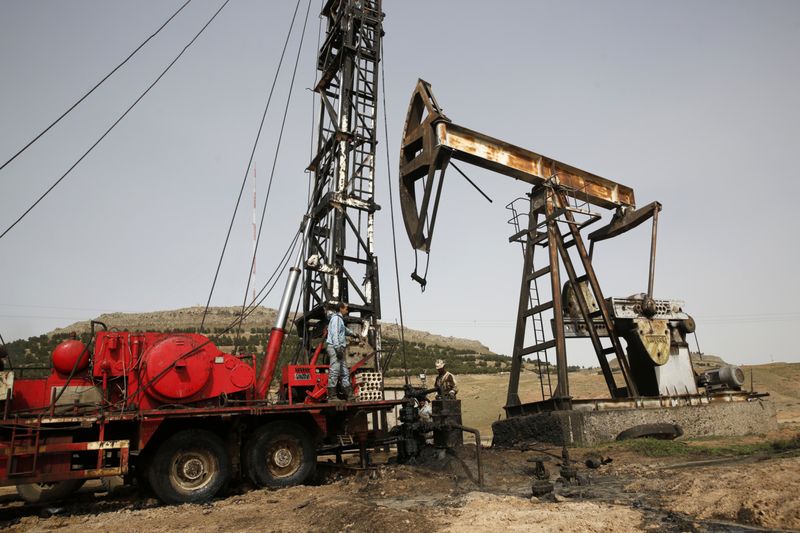
Beirut - The Syrian regime is scrambling to deal with its worst fuel crisis since the war began in 2011, aggravated by US sanctions targeting oil shipments to Damascus.
There was temporary relief when reserves or smuggled oil made their way to the market. Long lines outside gas stations slightly receded, as did public panic that had translated into widespread criticism of regime policies.
But more dramatic measures are necessary for the regime of President Bashar Al Assad, which needs to procure more than 75 per cent of its fuel from outside sources.
Experts say Damascus either has to regain control of oil-fields in the east, currently controlled by the US-backed, Kurdish-led Syrian Democratic Forces, or replace oil supplies that used to come from Iran with new ones from Russia - at a political cost.
Regime forces and their allies could make a quick move on the east if Washington goes ahead with talk of withdrawing its troops based there and working with the SDF. A US withdrawal would also offer Turkey a chance to launch its own assault to push away the SDF, which it considers a threat, and extend its borders. There are signs, however, the US may be reconsidering its plans.

Eventually, an offensive on the east is inevitable, said Fabrice Balanche, a Syria expert at the University of Lyon.
“When Turkey (attacks) the Kurds, Al Assad’s forces will (re)take Al Omar oil field. After 3 months? 6 months? One year?”
For now, Syria needs oil. Domestic production this year reached 24,000 barrels a day - only around 20-25 per cent of total needs - down from 350,000 barrels a day before the war. Regime officials say they need $2.7 billion worth of subsidised fuel every year.
Iran, which offered vital military support to Al Assad, was the main provider. But Tehran is feeling the heat as the US squeezes sanctions tighter.
The credit line Iran extended to Damascus since 2013 to supply oil has run dry and its oil shipments stopped late last year. This followed US Treasury sanctions imposed in November on a network that spanned Syria, Iran and Russia and was responsible for shipping oil to the Syrian regime. The Treasury also issued a global advisory warning of sanctions for illicit oil shipments, naming specific vessels and pressuring insurance companies. At least one tanker with Iranian oil headed to Syria remains docked outside the Suez Canal since December, according to TankerTrackers.com.
The Syrian pound dropped to one of its lowest values in years, going for 590 liras to the dollar on the black market compared to the official rate of 430 liras, and prices have skyrocketed.
Middlemen benefit from the sanctions by buying oil and bringing it in by land, usually from Iraq or Lebanon - providing around 20 per cent of Damascus’ needs. Some is smuggled in from the oil fields of eastern Syria, a trade that went on while the area was held by Daesh and continues under the Kurdish-led SDF. In recent days, activists and residents of Damascus spotted oil trucks crossing into regime-held areas.
In the long run, the SDF may have to negotiate a compromise with Damascus, given its precarious dependency on US protection. But for the moment, the SDF is seeking to enforce sanctions, tightening control over supply routes and securing bridges across the Euphrates River to regime-controlled areas. They banned the making of barges that carry oil across the river.
Russia can offer a stable supply to replace Iran’s. But to get it, Al Assad may have to recalibrate ties with his two main allies, Moscow and Tehran, which have different interests in Syria.
“The question is what Al Assad can offer in return and how profitable that will be for Russia,” said Kirill Semenov, Moscow-based Middle East analyst and a non-resident expert at the Russian International Affairs Council.
“Moscow could be using this to make Al Assad more pliable and act more in the interests of Moscow rather than Iran.”
Last week, the Syrian regime announced plans to lease the port of Tartous to Russia for 49 years for business. Russia already leases part of the port for its naval base.
The announcement followed reports in February that Iran was in talks to lease the nearby Latakia port in exchange for scrapping Damascus’ debts. That would allow Tehran access to the Mediterranean, right next to the Russian-run port. Moscow would be in a difficult spot with Israel, which has targeted Iranian bases in Syria and maintains a military hotline with Russia.
Russian Deputy Prime Minister Yuri Borisov met with Al Assad in Damascus at the end of April and said the Russian lease of the port would boost bilateral trade and benefit the Syrian economy. He lamented that the eastern oil fields are out of the regime’s reach but said “specific proposals” exist and that “Syria should be ready to solve (the problem).”
Syrian Minister of Transportation Ali Hammoud said Stroytransgaz, a leading Russian gas and oil company, would expand the port to more than double its current capacity and inject more than $500 million.
Stroytransgaz is not afraid of US sanctions. It is controlled by a close friend of Russian President Vladimir Putin who faces US sanctions since 2014 because of his connection to the Crimean crisis.
David Butter, an energy expert at Chatham House, said both Iran and Russia are using the fuel crisis as leverage on Assad.
“Iran wants guarantees of debt repayment” Russia seems to be angling for more political (and) military control,” he said. While Moscow has not yet spelled out what it wants, it is looking to “impose its will on the scope of any political settlement, to secure economic assets (and) control the military arena - elbowing out Iran.”
Leith Abu Fadel, founder and editor of the pro-Syrian regime site Al Masdar News, said Damascus “may choose the path set forth by the Russians,” including rapprochement with Saudi Arabia, Iran’s main rival in the region.
Late last month, Russian media reported that Putin’s envoy to Syria travelled to Damascus after a meeting with Saudi Crown Prince Mohammad Bin Salman where they discussed the Syrian crisis. Gulf countries, who had supported the armed opposition, have been making overtures to Al Assad aiming to pull Damascus out of Tehran’s orbit.












